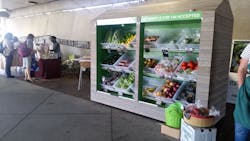Transit & Healthy Food: A Welcome Match in Atlanta
According to Feeding America’s Hunger in America 2014 study, more than 300,000 residents within the Metropolitan Atlanta Rapid Transit Authority’s service area lack reliable access to sufficient quantities of affordable, nutritious food.
Launched in 2015, the Fresh MARTA Markets provide convenient alternatives for fresh, affordable, locally grown produce. There are stands at four stations and each one operates one day per week offering fresh produce at a different station, Thursday through Friday, May through fall.
The markets are managed in partnership with the Community Farmers Market, Atlanta Community Food Bank/Food Oasis-Atlanta, South West Atlanta Growers (SWAG) Cooperative and Organix Matters.
MARTA GM/CEO Keith Parker said, “It’s better seeing a kid get off a bus or train, grab a peach and a fresh smoothie than the typical candy bar and soda that they do almost everywhere else. Us playing a role in that, I think is really neat.”
The Start of the Market
The market started as a pilot for four months the first season in 2015, as a table-top market.
Passengers were surveyed: Would you support a fresh produce market at the station? How often do you buy fresh produce? Where do you shop? Are you price sensitive? What’s the range of prices you would pay?
“All of the information from the survey was very, very positive,” said MARTA Manager, Retail Development & Concessions Planning Denise Whitfield. “We wanted to confirm the need and that [survey] confirmed it.”
The first year, another indicator of success was that they sold 8,000 pounds of fresh produce and had 3,500 people stop by.
A Community Need
Another partnership Whitfield talked about is with SNAP, the Supplemental Nutrition Assistance Program. “With SNAP, fresh for less here in Georgia, they can get two for one.
“With their $10 certificate, they can come here [Fresh MARTA Market] and get $20 worth of produce.”
She mentioned they are currently 20-40 percent SNAP sales.
“A lot of times we see because of low incomes, that you don’t have an interest in being able to eat more healthy, but it is not true,” Whitfield stated. “On any of these blocks, you’ll see … fast food; you won’t see this.
“Before we started, you might see here and there, people selling whatever on the side of the street. But now that it’s organized you have a full-blown customer commitment and this is only the third year.”
There are MARTA stations located within USDA-designated food deserts and there currently are Fresh MARTA Markets in two of them, though Whitfield said they hope to continue to grow.
Strong Partners
The organizations they partner with operate multiple farmer’s markets around the city, which has been part of the success of the markets.
“They’re the best at what they do,” Whitfield said. “We just happened to get lucky that they came to meet with me.
“Logistics is critical,” she said. “You have to have the right partners; you have to have the expertise to know where the produce centers are and how to get to it and how to get it delivered.”
A lot of the farmers are urban farmers, right in the area. With these partners, the farmers are able to grow and sell locally, to a much wider audience.
The first several months of operations they were running out of produce. They built storage on the back of produce stands because they were turning over produce so quickly. After about a month, Whitfield said they got it right.
While some stations, like Five Points, have the markets within the fare gates, there are others, like at the H.E. Holmes Station, where the markets are outside the gates, allowing for greater accessibility to the community.
Growing Local Entrepreneurs
Every Thuesday the Fresh MARTA Market is at the West End Station where there are several other vendors, including Haylene Green, “The Garden queen,” of the West End Community Urban Garden. She sells homemade ginger beer, hibiscus juice and soups.
Green said she grows all her vegetables, specializing in pumpkins – tropical pumpkins, she pointed out, not “Halloween pumpkins.”
Whitfield said all of the produce comes from the partners, which are local farmers. “It’s helping entrepreneurs,” she continued. “They actually sell to a lot of the restaurants that have farm-to-table produce on their menu. It’s a circle of success.”
The South West Atlanta Growers (SWAG) Cooperative is a group of farmers on 20 acres. She said, “They can actually buy in volume from them in a way that they’ve not ever been able to sell before because we have so many people coming through.
Starting a Market
For those looking to start a program, planning is crucial.
As MARTA receives funding from the Federal Transit Administration, Whitfield said they solicited for proposals so it was all done fair and square. The right partner had to be able to manage it, understand the logistics and have the volunteers to staff them.
While it relies heavily on grants, Whitfield said they need to figure out how to at least break even to take some weight off of the partners so that they can continue to grow the program.
The first year it cost $18,000 to operate.
Of the Fresh MARTA Market program, Whitfield said, “It’s all good. It would be tough to find something wrong.”
Visit a Market
Visit the Fresh MARTA Market from 3:00 p.m. - 7:00 p.m. during your visit.
The markets accept cash, credit and debit, as well as EBT/SNAP.
Tuesday
West End Station
Wednesday
H.E. Holmes Station
Thursday
College Park Station
Friday
Five Points Station
